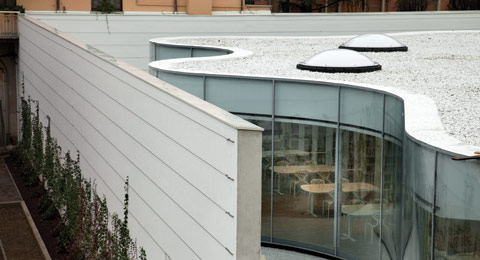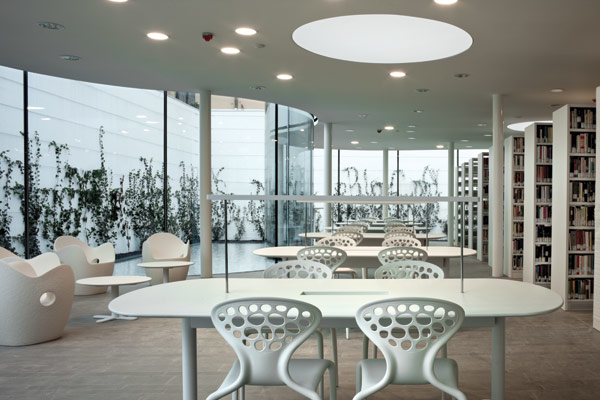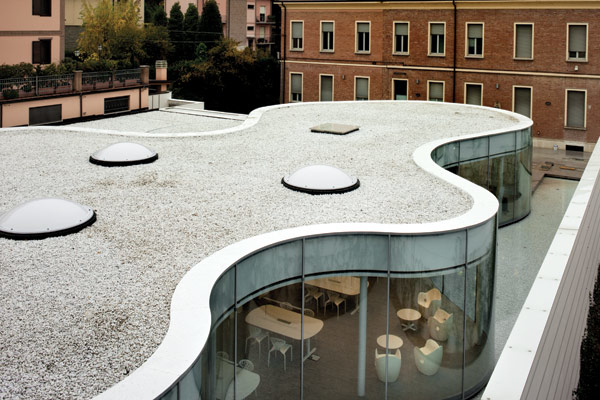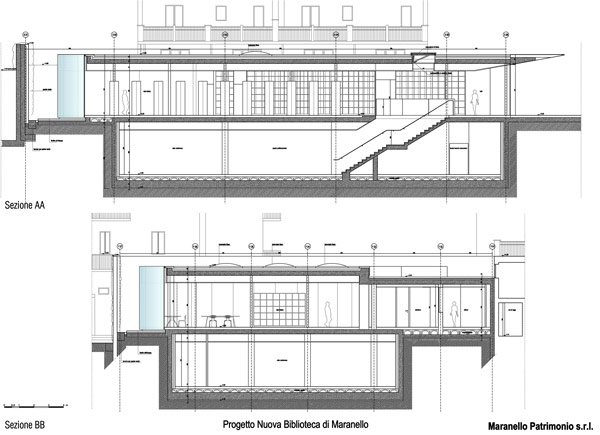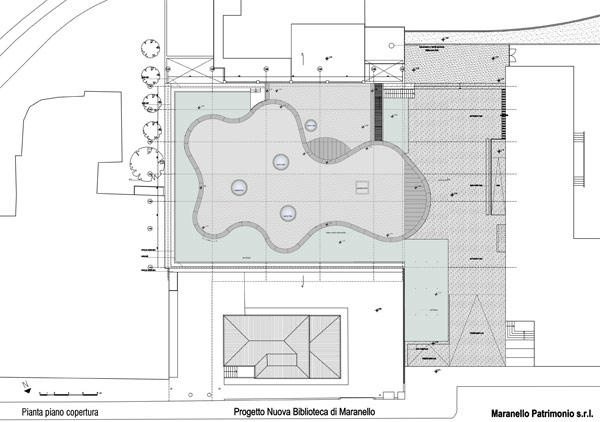Program: Biblioteka
Klijent: Maranello Patrimonio s.r.l., Maranello, Italija
Arhitekte: Arata Isozaki i Andrea Maffei
Projektantski tim: Alessandra De Stefani and Carlotta Maranesi, Simone Utzeri, Maurizio Petronio / Andrea Maffei Architects
Dimenzije:
površina parcele: 850m2
izgrađena bruto površina: 1.175m2
maksimalna visina iznad nivoa tla: 5.3 m
Materijali:armirani beton, čelik, paneli od zakrivljenog stakla
Vremenski okvir:
konkurs: April 2007.
projekat: Jun 2008. – Septembar 2009.
početak radova: Septembar 2009.
otvaranje: Novembar 2011.
Fotografije: Alessandra Chemollo
Nova gradska biblioteka u gradu Maranello u Italiji, koju su projektovali arhitekte Arata Isozaki i Andrea Maffei, otvorena je za javnost 19. Novembra 2011. godine. Izgrađena u blizini gradskog centra, biblioteka potvrđuje efikasnu sinergiju između javne uprave grada, koja odlučuje da investira u kvalitetnu arhitekturu, i arhitekata projekta. Arata Isozaki, jedan od proslavljenih majstora savremene arhitekture Japana, i Andrea Maffei, italijanski arhitekta koji je neko vreme radio u studiju Isozaki u Tokiju, danas kao partneri rade na nekoliko projekata u Italiji.
Zahvaljujući naporima javnih ustanova iz sfere planiranja grada kao i ulozi privatnih klijenata, naročito onih iz automobilske industrije (Ferrari ima svoje sedište u gradu Maranello), grad Maranello u poslednjih nekoliko godina doživljava arhitektonski procvat. Projekat biblioteke deo je ovog razvojnog poduhvata. Opština grada potvrdila je svoju zainteresovanost i odlučila da doprinese stvaranju savremenih prostora za kulturu i obrazovanje.
Nova biblioteka dobila je obličje 2007. godine kada je opština grada objavila konkurs “Progettare la Cultura” (“Projektovanje kulture”) na koji je prijavljeno skoro 150 radova iz Italije i drugih zemalja. Pobednici konkursa, arhitekte Arata Isozaki i Andrea Maffei, angažovani su da urade projekat biblioteke u junu 2008. godine, a izgradnja je počela u septembru 2009. godine. Projekat se od samog početka bavio aspektima održivosti, kontrole uticaja objekta na životnu sredinu i smanjenja potrošnje goriva.
“Namera opštine da ponudi novu uslugu gradu može se ostvariti jedino u vidu objekta koji se okreće budućnosti”, izjavili su autori.
Objekat definiše razređen prostor koji je savršeno postavljen unutar urbanog tkiva. Vijugavi oblici povezani su staklenim ravnima koje prate konturu objekta. Zahvaljujući toj transparentnoj membrani koja čini fasadu čitanje postaje “otvoren” doživljaj. On se manifestuje kao interakcija između učenja i posmatranja pejzažnog okruženja biblioteke. Objekat komunicira sa urbanim tkivom preko transparentnog korpusa. Osnovni cilj bio je ostvarenje direktne interakcije objekta sa gradom.
Smeštena u okviru rezidencionalne zone, biblioteka zauzima mesto prethodnog objekta čiji se tragovi i dalje nalaze na lokaciji: severni, istočni i južni spoljni zidovi. Ovi zidovi pokriveni su bršljenom koji zajedno sa reflektujućim bazenima u podnožju staklene fasade predstavlja novo prirodno okruženje koje se ostvaruje pred čitaocima i radnicima biblioteke. Danas, nova biblioteka u gradu Maranello pruža zajednici ambijent za čitanje, učenje, istraživanje i uživanje u prostoru koji je izdignut iznad vodene površine i obavijen zelenilom.
U objektu su smešteni različiti sadržaji: medijateka, igraonica, sala za rad, opštinska arhiva, izložbeni prostor koji se može iskoristiti za privremene instalacije, i prostorije za čitanje koje mogu da prime 90 ljudi. Svaki prostor za čitanje targetira određenu kategoriju čitalaca: odrasli, omladina i deca.
Sadržaji su raspoređeni na dva sprata. Na prizemlju u okviru krivolinijskog transparentnog volumena smešteni su kafe, prostori za izlaganje lokalnog kulturnog udruženja, i glavna prostorija za konsultacije i čitanje. Na južnom kraju biblioteke nalazi se neproziran deo objekta, beo kao biblioteka, u kome se nalaze uslužni prostori i stepeništa koja vode ka podrumskom delu i igraonici.
Andrea Maffei opisao je atmosferu, artikulaciju svetla, čistotu materijala i vitalnost zelenila koje okružuje biblioteku:
“Objekat se ogleda u vodenoj površini koja reflektuje intenzivnu boju bršljana na okolne zidove i površine. Nadstrešnica je izbačena u spoljašnji javni prostor i formira jedinstveni oblik koji čini arhitekturu objekta prepoznatljivom. U unutrašnjosti objekta potpuno beli podovi i beli nameštaj obasjani su zelenim nijansama zelenila koje se reflektuju o kontinualne staklene površine krivolinijske fasade. Svetlost koja prodire u prostor biblioteke rasprostire se u vidu igre refleksija svetlosti koja se odbija o bele elemente nameštaja, podove i zidove, površinu vode i kontinualnu transparentnu površinu stakla.”
Program: Library
Client: Maranello Patrimonio s.r.l., Maranello, Italy
Architects: Arata Isozaki and Andrea Maffei
Design team: Alessandra De Stefani and Carlotta Maranesi, Simone Utzeri, Maurizio Petronio / Andrea Maffei Architects
Dimensions:
site area: 850 sqm
built gross area: 1.175 sqm
maximum height above ground level: 5.3 m
Materials: reinforced concrete, steel, curved glass paneling
Schedule:
competition: April 2007
design: June 2008 – September 2009
beginning of construction: September 2009
opening: November 2011
Photography: Alessandra Chemollo
The new Town Library in Maranello, Italy, designed by architects Arata Isozaki and Andrea Maffei, opened to the public on November 19, 2011. Built near the center of the city, it substantiates the effective synergy between a public administration – that of Maranello, which is investing in pursuing an architecture of quality – and the designers: Arata Isozaki, one of the most celebrated masters of contemporary Japanese architectural culture, and Andrea Maffei, Italian architect who worked in Isozaki’s studio in Tokyo for several years and is now co-designing with him several projects in Italy, currently in development.
The project takes part of the flourishing architectonic development which the city of Maranello is experiencing in the last few years, thanks to the efforts of the public administration in planning its territory and its public spaces and thanks to the role of private clients, especially those belonging to the automotive industry which is particularly successful here (note: Ferrari has its headquarters in Maranello). In this scenario, the Municipality confirmed its interest in contributing to the creation of contemporary spaces for culture and education.
The new library began to take shape in 2007, when the Municipality di Maranello announced the open design competition “Progettare la Cultura” (“Designing Culture”) that received nearly 150 submissions from Italy and abroad. The winning architects, Arata Isozaki and Andrea Maffei, received the commission to design the library in June 2008; construction began in September 2009. From the beginning, the project took into account aspects of sustainability, control over the environmental impact of the building and the reduction of fuel consumption.
The architects stated that “the Municipality’s intention to offer a new service to the city could only take the form of a building that looks into the future”.
The building defines a rarefied space that is perfectly placed within the urban fabric. Its sinuous profiles are bound by glass plates that follow its contour: reading becomes an “open” experience by means of the transparent membrane that forms the façade. It manifests as an interaction between knowledge and the contemplation of the landscape that surrounds the library. The building expresses a dialogue with the urban fabric through the transparency of its body. The objective was to establish a direct interaction with the city.
Situated within a residential area, the library takes the place of a pre-existing building whose traces can still be found – the northern, eastern and southern exterior walls. These walls are covered with ivy, which along with the reflecting pools at the foot of the glazed perimeter make up the new natural horizons that are offered to the readers and patrons of the library. As of today, the new Library in Maranello offers the community an environment in which people can read, study, learn and enjoy a space that is suspended over a body of water and enveloped by greenery.
The building houses diverse environments: a record/video library, a playroom, a study hall, the municipal archives, an exhibition space that can be used for temporary installations, and reading rooms that can seat 90 readers. Each of these reading spaces targets a specific type of reader: adults, adolescents and children.
The program of the building is distributed over two floors. The curvilinear shape of the library contains on the ground floor a transparent volume that houses the cafeteria, the exposition spaces for a local cultural association, and the main room for consultation and reading. On the southern edge of the library, an opaque volume – white like the library – contains the services and staircases that lead to the basement and to the playroom.
Regarding the atmosphere, the lighting articulation, material purity and the vitality of the landscape that surrounds the library, Andrea Maffei wrote: “The volume is mirrored on a body of water that reflects the intense color of the ivy onto the surrounding walls and surfaces. A canopy juts out onto the public spaces which creates a unique form that renders the architecture recognizable even from the street. In the interior of the building the absolute white resin pavement and white furniture capture the green hues of the greenery that is reflected from the continuous glazed surfaces of the curvilinear façade. The light that pervades the open space of the library is exhibited in a play of reflections that bounce from the white elements of the furniture, the floors and structure, to the water and the continuous transparent glass.”


